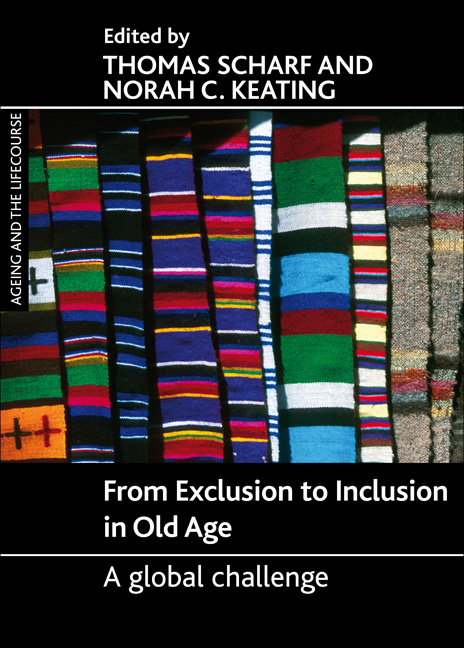Book contents
- Frontmatter
- Dedication
- Contents
- List of tables and figures
- Acknowledgements
- Notes on contributors
- Foreword
- one Social exclusion in later life: a global challenge
- two Globalisation, economic recession and social exclusion: policy challenges and responses
- three International migration: patterns and implications for exclusion in old age
- four Social inclusion of older people in developing countries: relations and resources
- five Exclusion from material resources: poverty and deprivation among older people in Europe
- six Social inclusion of elders in families
- seven The impact of changing value systems on social inclusion: an Asia-Pacific perspective
- eight Age discrimination as a source of exclusion in Europe: the need for a human rights plan for older persons
- nine Towards inclusive built environments for older adults
- ten Revisiting social exclusion of older adults
- Index
ten - Revisiting social exclusion of older adults
Published online by Cambridge University Press: 07 September 2022
- Frontmatter
- Dedication
- Contents
- List of tables and figures
- Acknowledgements
- Notes on contributors
- Foreword
- one Social exclusion in later life: a global challenge
- two Globalisation, economic recession and social exclusion: policy challenges and responses
- three International migration: patterns and implications for exclusion in old age
- four Social inclusion of older people in developing countries: relations and resources
- five Exclusion from material resources: poverty and deprivation among older people in Europe
- six Social inclusion of elders in families
- seven The impact of changing value systems on social inclusion: an Asia-Pacific perspective
- eight Age discrimination as a source of exclusion in Europe: the need for a human rights plan for older persons
- nine Towards inclusive built environments for older adults
- ten Revisiting social exclusion of older adults
- Index
Summary
Introduction
The exploration of global issues relating to ageing and social exclusion, undertaken by the contributors to this book, has resulted in convergences of theoretical perspectives and substantive understandings. Equally, it has highlighted regional and disciplinary differences in the importance of the multiple domains of exclusion and beliefs about appropriate policy responses. The authors have illustrated the need to be more critical in our exploration of inequalities among older adults and in the methodological rigour that is a precursor to filling knowledge gaps around the domains of exclusion and the risks for experiencing them. In this chapter, we address these issues, setting the stage for further the integration of research, policy and practice approaches to reducing risks of exclusion in later life.
Domains and drivers of social exclusion
In Chapter One, we presented five domains of social exclusion (from material resources, social relations, civic activities, basic services and neighbourhoods) that reflect the unique circumstances of older people. These were positioned as an orientation point for an interrogation of the extent to which older adults are excluded from specific features of societal participation. Across the chapters of the book, the authors have addressed these domains, emphasising some more than others and adding a critical lens to assumptions about the relationship between ageing and risks of exclusion. Factors increasing risks of exclusion were discussed in all chapters.
Exclusion from social relations was the most widely explored domain. At its core is exclusion from family relationships, a preoccupation in all world regions in response to population ageing. The authors have commented on regional discourses about how macro changes have affected families. These differ considerably. In East Asia the focus is on changes in filial piety; in Europe, on changing family structures and the individuation of risk; and in the middle-income countries of South America and Africa, on the evolution away from ‘generalised scarcity’ and on the effect of increasing financial security on family relations.
Through their examination of the modernisation of filial piety in East Asia, Phillips and Cheng (Chapter Seven) challenge the assumption that obligations dictated by filial piety are the necessary glue in generational relationships in families.
- Type
- Chapter
- Information
- From Exclusion to Inclusion in Old AgeA Global Challenge, pp. 163 - 170Publisher: Bristol University PressPrint publication year: 2012

